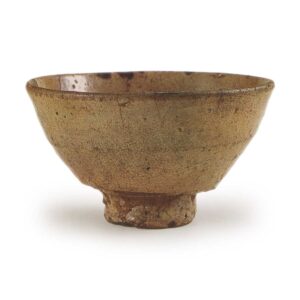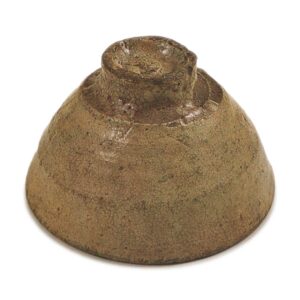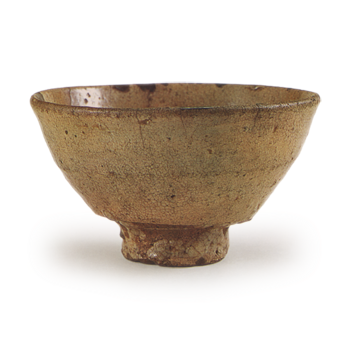

Height: 8.6cm
Diameter: 14.2-14.4cm
Outer diameter of foot ring: 5.1cm
Height of foot ring: 1.2cm
What is particularly prized about Oido ware is its imposing and dignified appearance, and in this respect, this Oido tea bowl, which is inscribed with the name of the previous owner, is highly regarded alongside Tsutsui-tsutsumi, and is truly the greatest of all Oido tea bowls. This is because it has been highly praised since ancient times.
The foot ring is deeply carved in a double circle, and the heavy bamboo-joint foot ring is even higher, giving the appearance of a pillar firmly planted in the ground. The overall shape also shows a form that rises high towards the heavens in a magnificent manner. Among similar bowls, it is the one that best displays the appearance of a large well, and it is the greatest highlight of Tsushima. It is also said that it was praised by tea ceremony enthusiasts in the Edo period, along with Tsutsui-tsutsui and Kizaemon.
One of the features of this teapot is that one of the rims is slightly higher than the others, perhaps due to the potter’s mistake when turning it on the wheel. The rough marks on the body of the pot, which extend to the bottom, were suddenly scraped off, and the change in the speed and rhythm of the scraping even conveys a metrical effect. The soft loquat-colored glaze shows the roughness of the natural glaze and the unevenness of the glaze, creating a natural scene, but the magnificent kaeragi (peony skin) extending from the side of the foot to the foot of the vase and the unglazed areas are also highlights that should not be missed. Inside the foot ring, the helmet-shaped lid stands proudly in the kaaragi pattern, creating a striking effect, and the tatami mat-shaped part of the bowl is almost completely worn away by the glaze, revealing the brown clay underneath.
One of the main attractions of Ido tea bowls is their unique clay taste. One of the key elements of tea bowl appreciation since ancient times has been the so-called “rough” feel of the clay, and the Ido tea bowl is the most typical example of this. is the feel of the hand-formed rim. This is partly due to the firing conditions, but the characteristics of the Ido clay are also thought to play a large role.
Even with the Ido-style copies made in Japan, the quality of the clay is still the most important factor, and in this respect, the early Hagi ware that was made with the aim of imitating Ido ware is the most reminiscent of the true Ido clay. In the case of Karatsu ware, the clay has a slightly low iron content, and the pieces are fired hard, so they are smooth and have the disadvantage of being prone to small cracks. It seems that the early Kyoto kilns also tried their hand at imitating Ido ware, and we can see the traces of their painstaking efforts to do so, using Kurotani clay as a base.
Another characteristic of the fine pieces of Oido ware is their deep interior. The Tsushima well is also very deep, and the small nuki-iri pattern of the tea whisk is also wonderful.
The depth of the well is not noticeable, but it is said that this is because it was placed on top when it was fired. Kizaemon, Hosokawa and Kaga are also not noticeable in the depth of the well. This is probably why Tsushima is placed in the same category as Mitsui-do in the Oido Chuhyaku. It was originally owned by the former governor of Tsushima, and later passed to Osaka, where it was called a tea bowl worth 1,000 kane during the Meiwa era. Later, through the mediation of Tanimatsuya Socho, it became the property of the feudal lord Sakai of Wakasu Obama in 1849 for the sum of 1,000 ryo. In recent years, it has been in the collection of a certain family in Osaka.



